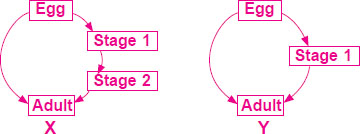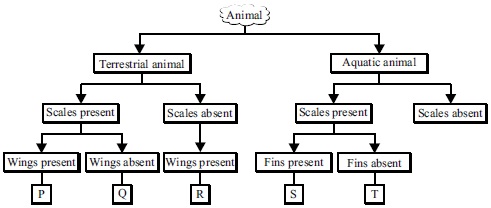Subject :NSO Class : Class 5
Subject :NSO Class : Class 5
Post Your Answer
Subject :NSO Class : Class 4
Two life cycles are represented here.

Now, select the correct option regarding them.
| X | Y | |
| A | Cockroach | Butterfly |
| B | Housefly | Silkworm |
| C | Frog | Cockroach |
| D | Butterfly | Frog |
I think the correct answer is C because as the answer D as given has Y option as frog but the frog have 4 stage life cycle
Ans 2:
Class : Class 4
The ans cannot be D frog has 4 stages ie Egg , Tadpole, (tadpole with legs ) Young adult, Adult
Ans 7:
Class : Class 5
the answer should be C as a frog has 4 stages in its life cycle,spawns,tadpole,tadpole with legs and a adult frog
Ans 9:
Class : Class 8
THE ANSWER SHOULD BE C NOT D BECAUSE FROG HAS 2 STAGES ,AND COCKROACH HAS 1 STAGE IN BETWEEN EGGS AND ADULTS.
Ans 12:
Class : Class 8
In X both frog and butterfly is there.Frog: Spawn , Tadpole ,Tadpole with legs and adult frogButterfly : Eggs ,Larvae, Pupae ,Butterfly So There is CONFUSION And answer is C asCockroach :Egg ,Nymph ,Cockroach SOF erase this confusion somehow Ashmi Narkar
Ans 13:
Class : Class 5
Answer C is right.Frog has 4 stages - Egg, tadpole, froglet and adult frogCockroach has 3 stages - Egg, nymph and adultAs per your answer, frog option is wrong for 3 stages
Ans 14:
Class : Class 9
Frog has 4 stages of life cycle Egg- Early Tadpole - Young Adult ( Tadpole with legs ) - Adult Frog and Cockroach has three stages of life cycle Egg - Nymph - Adult Cockroach . Hence, option - C is correct.
Ans 16:
Class : Class 5
It should be c because frog has 2 stages between egg and adult while cockroach has 1 stage between the egg and adult
Ans 18:
Class : Class 6
If this kind of mistakes you guys are doing in the course materials and practice tests then it is not good. I will not rely on your training materials. I emailed you guys the mistakes done in Prep Guide also. I am disappointing with the material.
Ans 19:
Class : Class 5
The answer is C as Frog has 4 stages in its lifecycle - Egg, Tadpole, Tadpole with Legs and Adult.
Ans 21:
Class : Class 8
I agree with all those who gave CI am as sympathetic as I can be and as for all those who said D I am very very angryAnd as for all those who said DThey are completely WRONG and SILLYSOF and Dinesh Kr.Pandey seeThe effect of your wrong answer DIs now creating a confusionAnd please give us all the correct explanation
Ans 22:
Class : Class 6
It should be C as a frog has four stages that is an egg, a tadpole, a tadpole with legs and a frog; while a cockroach has three stages that is egg, nymph and cockroach.
Ans 27:
Class : Class 3
Well, the correct answer is showing D. I mean is D is the correct answer? No, it is not. If u see here the answer will be C. How? This is the life cycle of a frog - First it other frogs lay eggs. Then it grows to a tadpole. Then to a froglet. And then lastly it grows into an adult frog. So, it has 4 stages. And then for cockroach, it has 3 stages which are - Eggs into a Nymph and then into an adult cockroach. So, that is why the correct answer will be C and not D.
Ans 30:
Class : Class 9
lipi from shalom hills international school , gurugramclass:ANSWER SHOULD BE C AS FROG LIFE CLYCLE HAS 4 STAGES-EGGS , TADPOLE , TADPOLE WITH LEGS , ADULT
Post Your Answer
Subject :NSO Class : Class 5
Post Your Answer
Subject :NSO Class : Class 5
Ans 1:
Class : Class 7
Since ''y'' is ice ,thermocol is the only material from the following which will prevent the ice from melting.
Ans 5:
Ans 20:
Class : Class 8
Yes it is c. Thermocol. But the picture was not clear. I had to use magnifying glass.
Ans 22:
Class : Class 8
Thermocol is a good insulating material as it is a bad conductor of heat. Ice cubes kept in thermocol box will not melt for a longer time
Ans 23:
Class : Class 9
It is thermocol , and how donât u ppl not know the answer , it was written in the synopsis!!
Post Your Answer
Subject :NSO Class : Class 4
Post Your Answer
Subject :NSO Class : Class 5
Post Your Answer
Subject :NSO Class : Class 7
Ans 1:
Class : Class 9
The correct answer is 'd'. M/s^2 or metre per second square. That is because the formula for acceleration is change in velocity /time.
The SI unit of velocity is m/s (as it is displacement /time) and the SI unit of time is second. So the SI unit of acceleration is m/s/s which can also be written as m/s^2
Ans 5:
Class : Class 8
option D is correct as
Average acceleration=Final velocity - Initial velocity/Change in time
Post Your Answer
Subject :NSO Class : Class 4
Select the correct sequence of words to fill the blanks in the following sentences.
(A)  fibres do not absorb sweat.
fibres do not absorb sweat.
(B)  and
and  wear white coats.
wear white coats.
(C)  is the national dress of Korea.
is the national dress of Korea.
| 1 | 2 | 3 | 4 | |
| A | Natural | Lawyers | Doctors | Kimono |
| B | Synthetic | Policemen | Firemen | Mundu |
| C | Natural | Gardener | Plumber | Phiran |
| D | Synthetic | Doctors | Nurses | Hanbok |
Ans 8:
Class : Class 9
Bhavya, If Phiran the traditional dress of Korea,then who wears white coats-gardeners and plumbers or doctors and nurses !!!!!! Correct answer is D. Don`t make fun of yourself . Everyone in my family is laughing at you.
Post Your Answer
Subject :NSO Class : Class 5






